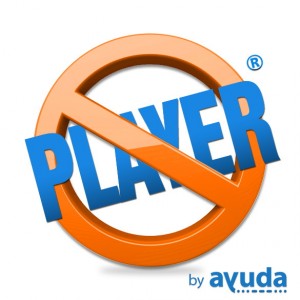Adrian J Cotterill, Editor-in-Chief
Ever since we have followed Ayuda Media Systems they have approached trade shows with a passion – never being afraid to demonstrate a proof of concept and this year at #dse2013 was no different with a demonstration of their idea for a No-Player Player (yes read that again carefully, a ‘No-Player Player’).
Pierre Yves Troël, Partner & Chief Software Architect at Ayuda Media Systems, also leads the ‘Ayuda Labs’ department (the group of developers/techno-junkies who continually experiment with new technologies for the OOH industry) and he told us “First we donated our player to the industry. Now, we’re killing the player entirely”.
Ayuda unveiled what they call the ‘No-Player Player’ last week at #dse2013.
The Ayuda Platform, which we all know, helps Outdoor and Place Based networks manage all aspects of their OOH business, includes the Splash digital signage CMS which now no longer requires any endpoint software players to display content!
Splash now has the optional capability to send content directly to any HTML5 enabled browser – any player device or TV with a built-in browser will be capable of displaying digital signage, without having to worry about installing any software or paying the associated per-player fees that digital signage software makers typically charge.
Pierre Yves Troël said “HTML5 has evolved and (has) come a long way insofar that it has now become a full-fledged graphics subsystem. It has full support for h.264 video, raster, vectors, fonts, and CSS3 animations. Given the potential of this graphics subsystem, we beg the question as to whether a player device will still be necessary going forward”.
He continued “Today we have the concept of the ‘smart TV’ – displays that almost unanimously come equipped with built-in operating systems and HTML5 browsers. Ayuda’s ‘No-Player Player’ leverages this trend and replaces the dedicated hardware and software player with a URL generated by the Splash CMS, that can be ingested by any HTML5 browser”.
As a player’s main purpose is to play looped media; we saw at #dse2013 that HTML5 can play the same looped media in full HD – possibly eliminating one of the main reasons to have additional hardware and software in the field, beyond the smart TV.
Troël notes that this innovation has only become possible recently, as browsers have begun closing the loop on implementing full HTML5 specifications. “HTML5 is the new runtime. A windows player application might be built on the .net runtime, while an android player might be Java based, for example. But with HTML5, you don’t need a runtime. HTML5 – the browser – IS the runtime”.
While this proof of concept shows a promising direction for reducing networks’ costs and simplifying field installations, there are other considerations that need to be addressed before browser based playback can fully replace a physical player and dedicated player software.
Troël added “While we acknowledge that this tangent we’re exploring today does not yet have the ability to act diagnostically, we believe that future HTML5 specifications may evolve to include the ability to obtain diagnostic information. When that happens, we’ll be much closer to saying goodbye to the segregated player device”.
For those networks who today don’t necessarily need player diagnostic capabilities in their networks, Ayuda is already offering the No-Player Player as an alternative.


March 5th, 2013 at 22:02 @960
So let me get this straight? The Splash CMS “generates” a player – which is really a bit.ly URL.
Then you go to any HTML5 compliant device and navigate to the URL and see the looped content playing AND this is all possible thanks to HTML5?
As many screens have built in browsers, and their HTML5 compliance will only get better over the years – then surely if that happens, will we ever really need to install a player in the future?
March 6th, 2013 at 15:21 @681
Your understanding is correct. And yes, to answer your question, the idea is that one day, perhaps we won’t need to install a player at all! As it stands now however, an HTML5 “player” is more of a “light” player than a fully fledged replacement (diagnostics etc.), but yes, full HD playback does work as of today.
March 6th, 2013 at 15:42 @696
That’s fantastic in principle, but I’d be worried that you’re effectively relying a piece of software that is not designed for 24/7 use. It seems to be that whilst the approach of using HTML5 as a markup standard is a valid one to persue, the potential for memory leaks and other reliability and security problems caused by using a browser should not be discounted just because it’s a low cost way of doing this. You’re also then completely reliant on solid connectivity to avoid ‘server not reachable’ errors, which we all know is not that simple to achieve in many instances.
March 6th, 2013 at 18:49 @825
A little clarification that in my original comment… the phrase “light player” was inaccurate – there is NO player at all. Just the browser and its implementation of the HTML5 spec, which is getting better every day.
The only thing “light” about using the browser as a player is the lack of diagnostics today, but let’s see where this heads down the road 🙂